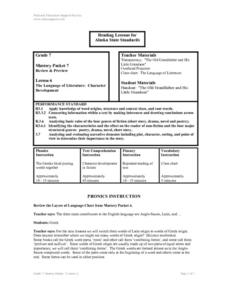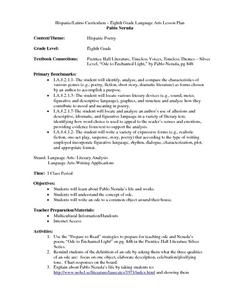Curated OER
Poetry and Our National Anthem
Students express the meaning of the Star-Spangled Banner. In this American history lesson, students read through the national anthem and complete an activities from a list of choices. Some choices include: writing the anthem in your own...
Curated OER
Language Arts Exploration
While an interesting lesson plan idea involving the exploration of a story about an Asian American boy named Imduk, a teacher would need to have assess to the Scott Foresman reading program to make this work. If not, a teacher could use...
Curated OER
Responding To Rembrandt's Work Through Poetry
Students write poetry in response to Rembrandt's landscapes and portraits. They create accompanying illustrations based on interpretations of Rembrandt's work and present them along with the poems in book format.
Curated OER
Night by Elie Weisel
Students read "No News from Auschwitz" and answer the study questions as an introduction to the novel. They record reactions to the essay and compare with reactions after reading "Night".
Curated OER
Using Southeast Asian Folktales to Teach Reading and Writing
Students use maps to locate the countries of Thailand, Vietnam and Cambodia. In groups, they compare and contrast the three countries in regard to their culture, morals and values. They read various examples of folktales and write their...
Curated OER
Tantalizing Tangrams
Learners construct a set of tangrams. For this geometry lesson, students read the book, Grandfather Tang's Story and retell the story using tangrams. Learners construct their own set of tangrams using the included worksheets.
Curated OER
Greek Origins and Character Development
Seventh graders examine words of Greek origin and discuss character development in fiction. They read a list of Greek word parts and create words on a worksheet. Students then read and discuss an informational handout about character...
Curated OER
Write a Myth
Students explore myths in ancient times. In this mythology lesson, students read or view a video production of a myth to determine specific characteristics of myths. Students work in groups to write a myth that explains an...
Curated OER
Analysis of Character in a Short Story
Ninth graders examine a character from the short story, John Steinbeck's, "Flight." students respond to questions about the story and illustrate the character's journey.
Curated OER
Time Travel, Black Holes, and Relativity
Young scholars read the novel, The Time Machine, and compare H.G. Well's perceptions of the future with those presented in The Third Wave, by Alvin Toffler. They research current scientific and mathematical theories that relate to space...
Curated OER
Comparing Fairy Tales
Learners read and review common fairy tales and come up with a list of characteristics from them. The Teacher models filling out either a compare & contrast graphic organizer comparing two fairy tales.
Curated OER
Cause and Effect
Young scholars identify cause and effect relationships in a short story. After reading a short story, they participate in a discussion of how one event in a story can lead to several others. Students are then paired for a matching task...
Curated OER
Folktales around the World (Middle, Reading/Writing)
Students analyze, synthesize, and use the elements of various US cultural folk tales to describe the elements of fiction in general and in folk tales specifically.
Curated OER
The Stinky Cheese Man and Other Fairly Stupid Tales
Sixth graders demonstrate the ability to process and evaluate content from a variety of sources and apply comprehension skills to the material read. They organize information for practical use and design and develop an informational...
Curated OER
Language Arts: Character Comparison
Fourth graders, using Kidspiration, compare and contrast the two main characters from Tales of a Fourth Grade Nothing. They use a teacher-created template to describe their characters. Students then create their own character analysis.
Curated OER
Language Arts: Character Analysis
Fourth graders identify the character traits of Peter in Tales of a Fourth Grade Nothing. They find quotations in the story that illlustrate the traits. Students use Kidspiration to write their reports on a template.
Curated OER
Pablo Neruda
Eighth graders explore the life and works of Pablo Neruda. They complete an author map concerning his personal and professional life. Students identify the key components of an ode. They write an ode to a common object around their...
Curated OER
Poetry
Fifth graders preview different poetry selections form different poets to narrow their criteria for a favorite poem. They use the web and written sources to find a favorite poem and then give an oral interpretation of their poem in class...
Curated OER
What's In A Name
Second graders read Chrysanthemum by Kevin Henkes. They then discuss where various names come from. They create a individualized biopoem and publish it on word processing software. Their poems are compiled into a class book and presented...
Curated OER
Ida Tarbell: Hysterical Woman vs. Historical Facts
Learners examine journalism and its different styles. In this effective communication instructional activity students create an editorial message and articulate an article.
Curated OER
My Favorite Things
Students identify "masterpieces" and mass-produced objects. They explain why they value a given object and determine what physical materials were used to create the objects. They create a class book featuring objects that they value.
Curated OER
Using Picture Mapping to Improve Student Comprehension
Students draw pictoral representations of a reading selection they read in order to recall information. In this picture mapping lesson plan, students use pictures to comprehend what they read and sequence the pictures as well.
Curated OER
Women in the White House
Eleventh graders explore the role and impact of recent First Ladies through research and family interviews, then work in groups to present a documentary portrait to the class.
Curated OER
Memior: The Stuff of Our Lives
Fourth graders reflect upon the significance of remembered events and to keep a "notebook" of their thoughts and feelings. They read books that exemplify memior writing. They write their memiors, taking it through the writing process.























